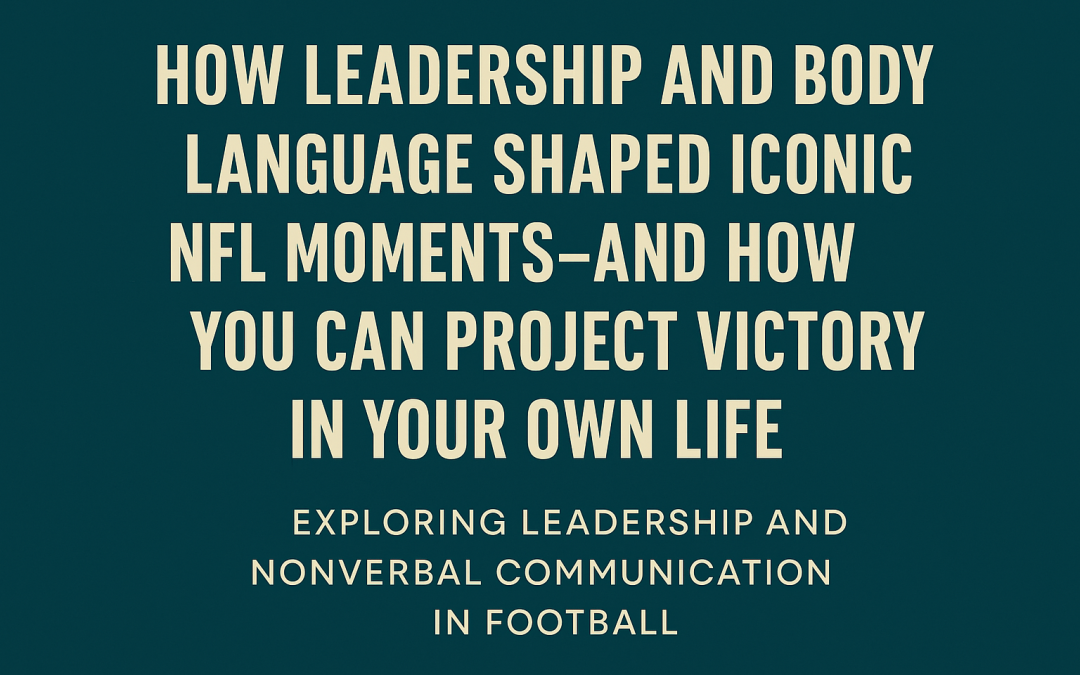It’s football season, and millions of Americans and people all over the world are enjoying watching the games. One aspect of football that stands out to me is the importance of leadership, especially from quarterbacks.
When I was a boy, there was a competition to determine who would be the starting quarterback for the Dallas Cowboys. Craig Morton was an outstanding quarterback. Roger Staubach was his competitor. Roger Staubach was a Heisman Trophy winner, a graduate of the United States Naval Academy, and a veteran who served in Vietnam.
One significant problem with Craig Morton was his body language. Whenever he made a bad play or when his team was losing, his body language conveyed defeat. It was hard to describe, but his nonverbal communication was clear. Staubach, on the other hand, exhibited a body language that signaled victory. It reflected his determination to win and his competitive spirit. This difference in nonverbal communication not only affected their individual performances but also impacted their team dynamics in meaningful ways. Morton’s defeatist body language could demoralize his teammates, while Staubach’s victorious posture could inspire them to keep fighting.
The highlight of this was the season after Staubach led the Cowboys to their first Super Bowl victory. They were playing the San Francisco 49ers in the playoffs in San Francisco. Dallas had beaten San Francisco the previous two seasons for the NFC championship. In this game, the Cowboys were losing 28 to 13. Staubach had suffered a separated shoulder in the preseason, so he had not played during the regular season. But he had recovered enough to be available in the playoffs. Craig Morton started, but things got so bad that in the fourth quarter, coach Tom Landry sent Staubach into the game.
Early on, Staubach experienced a negative play that changed the tide. A 49ers player grabbed Staubach when he was attempting to pass and shut the play down. But he did not shut Staubach down. Staubach remained on his feet. Another 49er joined his teammate in the attack, but Staubach remained erect. Then a third 49er and a fourth 49er piled on. All savagely assaulted Staubach, but Staubach remained standing. Sportswriter Sam Blair wrote that you could see the sheer determination in Staubach’s face; he would not be brought down. Finally, the referee gave up and blew the whistle. Starbuck was still standing. This moment galvanized the Cowboys. They came back to win 30-28, with Staubach throwing two touchdown passes in the last two minutes of the ball game. It was a miraculous win.
But it doesn’t have to be quarterbacks only who project victory. My all-time favorite story about nonverbal communication involves a former Dallas Cowboys kicker, Tony Fritsch. During the first season that the Cowboys won the Super Bowl, they faced tremendous peril. Their record stood at four wins and three losses, and they were on the verge of being knocked out of playoff contention. They were playing the Cardinals on the road, and the game was tied 13 to 13. With less than two minutes left in the game, Roger Staubach drove the Cowboys into field goal range.
The starting kicker had recently been injured, so the Cowboys signed Fritsch, a kicker who had retired from soccer in a European league. He had never kicked in a football game until that day and suddenly found himself in a high-pressure situation.
Before Fritsch could kick, the Cardinals called a timeout to apply more pressure upon him. The Cardinal fans began booing and whistling catcalls at him, while the Cardinal players yelled and cursed. One of the Cowboy linemen, Larry Cole, chided his opponents, “You might as well forget that. He doesn’t speak English.”
How would Fritsch respond to the crowd’s hostility? In a way that no one expected. Like an orchestra conductor, Fritsch turned towards the crowd and waved his arms as if he were conducting an orchestra and choir. Instead of feeling intimidated, he thoroughly enjoyed the moment. And why not? It made him think of home, where European soccer fans behaved similarly at their matches. Soon after, the ball was snapped, and Frisch kicked the game-winning field goal. He had faced a choice; he could have projected defeat. Instead, he projected victory.
Which do you project, victory or defeat? Your choice can make a lot of difference. Several authors have explored this topic, along with other forms of nonverbal communication. Two of my favorites are Vanessa Van Edwards, in her book Cues, and Amy Cuddy, in her TED Talk https://www.youtube.com/watch?v=Ks-_Mh1QhMc.
Most people who project defeat are not even aware of it. Study yourself, and make the decision to project victory. Stand tall, maintain eye contact, and convey confidence and determination. These are simple yet powerful ways to project victory in your nonverbal communication.
Mark
Dr. Mark Edge
The WorkEdge Company
Telephone: 903-245-7851
Email: workedgetexas@gmail.com
Website: www.workedgetexas.com
Author of Holy Chaos To purchase the book, click here:

